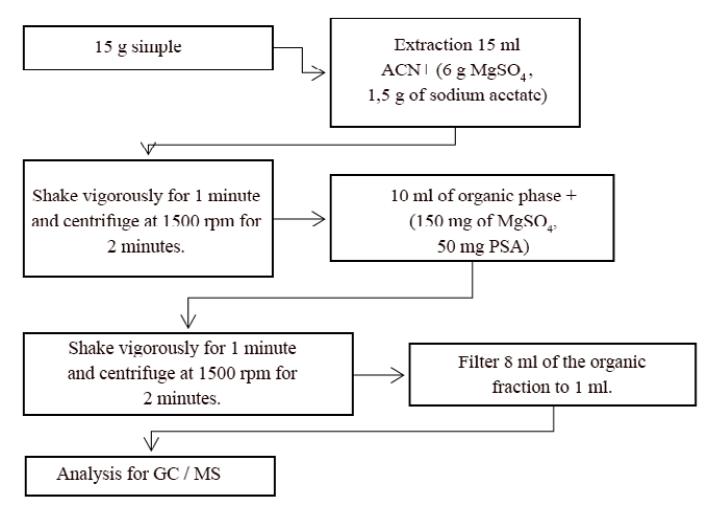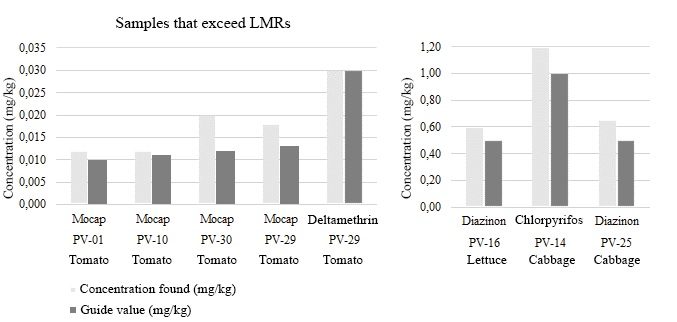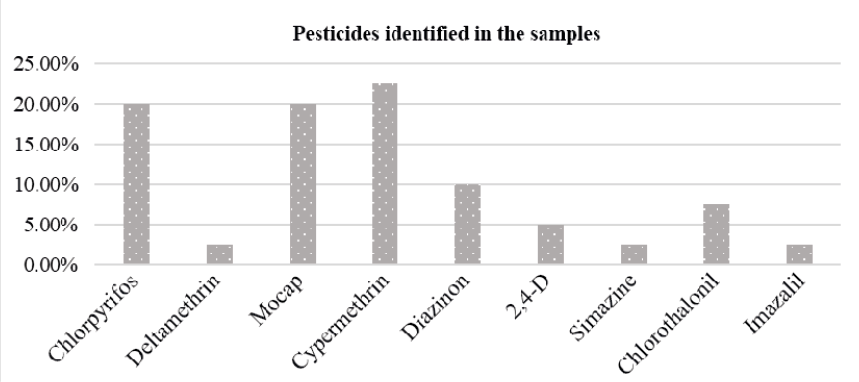ISSN 2410-5708 / e-ISSN 2313-7215
Year 8 | No. 23 | p. 142 - 152 | October 2019 - January 2020
© Copyright (2020). National Autonomous University of Nicaragua, Managua.
This document is under a Creative Commons
Attribution-NonCommercial-NoDerivs 4.0 International licence.
Identification and quantification of pesticide residues in vegetables of high consumption commercialized in markets and supermarkets in Managua
https://doi.org/10.5377/torreon.v8i23.9532
Submitted on December 18th, 2019 / Accepted on January 29th, 2020
MSc. Josseth Mhartin Díaz Domínguez
Master in Environmental Management
Center for Research in Nicaraguan Aquatic Resources Organic Pollutants Laboratory
UNAN-Managua, CIRA
Keywords: codex alimentarius, maximum residues limits, pesticides, plant matrix
Abstract
The use of pesticides for pest control is a common practice in agricultural production systems of Nicaragua. In this study 21 pesticides (7 organophosphorus insecticides, 1 organochlorine insecticide, 3 pyrethroid insecticides, 7 herbicides and 3 fungicides) were studied and determined in samples of tomatoes, peppers, lettuce and cabbage collected in 2 popular markets and 2 supermarkets of Managua.The analysis reflects that 55,0% of the samples contain pesticides, managing to identify residues of chlorpyrifos, mocap, cypermethrin, chlorothalonil, imazalil, diazinon, deltamethrin, simazine and 2,4-D, in concentrations between 0,005 mg/kg up to 5,3 mg/kg. 20,0% of the samples contain residual variables that exceed the values established in the Codex Alimentarius in the matrices lettuce (diazinon), cabbage (chlorpyrifos and diazinon), tomato (mocap and deltamethrin).
Note: This was a Master thesis project in Environmental Management funded by the funds for research projects of UNAN-Managua and CIRA/UNAN-Managua developed in the period 2016 - 2018 under the line of research: Food safety and human health.
1. Introduction
Nicaragua is a country with great agricultural activity, the use of agrochemicals for pest control is very common especially in non-technified mono crop systems; This entails proper management of the pesticides that are applied, however, in some cases due to ignorance by the producer, there may be indiscriminate use of the pesticides (Millennium Challenge Account Nicaragua, 2007). The handling and application of pesticides can entail risks for the human being, either as a user or consumer of vegetables, fruits and treated products (Pérez, Navarro, & Miranda, 2013).
The use of agrochemicals in pest control must be carried out in accordance with what is established in the safety regulations, these establish maximum permissible residue limits so that the risk in consumers is minimal (Pérez, Navarro, & Miranda, 2013). That is why some International Government Agencies (eg, USFDA: United States Food and Drug Administration) and International Organizations (eg, Codex Alimentarius Commission CAC FAO/WHO: Food and Agriculture Organization of the United Nations/World Health Organization) have established maximum limits for pesticide residues (MRLs) in products of animal and plant origin for human or animal consumption. The main objective of the MRLs is to protect the health of consumers, although they also help to promote fair international trade by ensuring clear trade practices and improving coordination of all food standards (CAC, 2011).
In Nicaragua, agricultural products can carry unwanted pesticide residues due to the lack of application of regulations that control their indiscriminate use, so this study aims to identify and quantify pesticide residues in high consumption vegetables and determine if they comply with the maximum levels of pesticide residues established in the Codex Alimentarius.
2. Methodology
2.1. Sample collection and pretreatment
The samples were collected in two popular markets and in two supermarkets in Managua, these sites are routinely visited by people from different districts of this city to make their purchases. This study contemplated the analysis of 40 samples (Table 1) including samples of tomatoes, pepper, lettuce and cabbage, these vegetables are in strong demand in the markets and supermarkets of the country, are routinely consumed in the diet of the inhabitants being this an important reason to determine the presence of pesticide residues in these foods.
Table 1. Sample collection sites
|
Sample collection site |
Number of samples |
TOTAL |
|||
|
Tomato |
Pepper |
Cabbage |
Lettuce |
||
|
Popular markets |
6 |
6 |
6 |
6 |
24 |
|
Supermarkets |
6 |
2 |
4 |
4 |
16 |
|
TOTAL |
12 |
8 |
10 |
10 |
40 |
The sampling procedure and the size of each sample was performed following the recommendations of the Nicaraguan Compulsory Technical Standard NTON-17002-02 (2001). This is a standard of procedures for sampling plant products. In the case of tomato, lettuce, onion and pepper samples, 1 kg of product was taken for each sample or at least 10 units and for the cabbage 5 units were collected per sample (NTON-17002-02, 2001). Once the samples were entered into the laboratory they were homogenized using the method of cracking, the sample was finely chopped with a stainless steel knife and a portion of it was crushed using a laboratory mixer (BLENDER 31BL91) until a homogeneous mixture was obtained.
2.2. Sample extraction
The purpose of a laboratory is to produce relevant and reliable information (data) for decision making. These data must be obtained with reliable, accurate and adequate analytical techniques for their purpose (UNODC, 2012). The sample analysis was carried out in the Organic Pollutants Laboratory of the Center for Research in Aquatic Resources (CIRA / UNAN), the extraction procedure was performed as described by the method of the International AOAC (AOAC 2007.01) “Pesticide Residues in food by extraction of acetonitrile and partition with magnesium sulfate”. (Fig. 1) Also called the QuEChERS method (fast, easy, cheap, effective, robust and safe) this method is routinely used for the analysis of pesticides in vegetables by many international testing laboratories.

Figure 1. Extraction of pesticides in vegetables.
An aliquot between 10.0 to 15.0 grams and 15.0 ml of HPLC grade acetonitrile are added into a 50.0 ml falcon tube, then the total contents of the QuEChERS AOAC extraction kit (6.0g of Magnesium sulfate and 1.5 g of sodium acetate anhydride) (Scharlau QUEXTAOAK1), stir vigorously for 1 minute and centrifuge (Centrifuge Thermo scientific, Sorvall ST 16) for 2 minutes at 1500 rpm.
For cleaning the extract, a 10.0 ml aliquot of the organic extract is measured and placed in the Falcon tube containing QuEChERS dispersive AOAC kit (1.20 g of magnesium sulfate and 0.40 g of primary/secondary amine, PSA) (Scharlau QUDISAONK2) is vigorously stirred for 1 minute and centrifuged 2 minutes at 1500 rpm.
A 8.0 ml aliquot of the organic extract was collected and deposited in a 12.0 ml test tube and evaporated to an approximate volume of 0.30 ml with a stream of inert nitrogen, then adjusted to 1 ml with HPLC grade acetonitrile.
Among the pesticides analyzed in the extracts of each sample are 7 herbicides (atrazine, pendimentaline, 2,4-D, simazine, terbutrine, ametrine), 3 fungicides (propiconazole, chlorothalonil and imazalil) and 7 organophosphorus insecticides (chlorpyrifos, terbufos, methamidophos, mocap (etoprofos), methyl paration, malation, diazinon), 3 pyrethroid insecticides (cypermethrin, trans-permethrin, deltamethrin) and an organochlorine pesticide (endofulfan). The use of these agrochemicals is allowed in the country for the control of different pests (UNIVERSIDAD NACIONAL DE COSTA RICA, 2019), however, in some cases it is marketed under the commercial name and the farmers do not know the active principle of it, (eg , Bravonil 72 SC, active substance chlorothalonil)
2.3. Instrumentation and chromatographic conditions
The sample extract was injected into a gas chromatograph (Agilent 7890A) with triple quadrupole mass spectrometer detector (Agilent 7000B). Oven programming 40 °C, hold time 1 minute, 40 °C/min up to 120 °C, 5 °C/min up to 240 °C, 12 °C/min up to 300 °C, hold time 6 minutes; injector temperature 250 °C; injection volume 1 µl; helium carrier gas with flow of 1 ml/min. The mass spectrometer conditions were: source of electronic impact ionization; ionization voltage 70 eV; ionization source temperature; 280 °C transfer line; Quadrupole temperature Q1 150 °C, Q2 150 °C.
3. Results
The results of the sample analysis reflect the presence of 9 pesticides, of the pyrethroid insecticide type (cypermethrin, deltamethrin); organophosphorus insecticides (mocap, diazinon); fungicides (chlorpyrifos, imazalil, chlorotalonil) and herbicides (simazine, 2,4-D). The concentrations detected are variable, from 0.005 mg/kg to 5.3 mg/kg. Some concentrations exceed the maximum residue values established in the Codex Alimentarius.
Table 2. Insecticides identified in the samples
|
Matrix |
Code |
Pesticide |
Concentration found (mg/kg) |
|
Tomato |
PV-01 |
mocap |
0,012 |
|
PV-02 |
2,4-D |
0,300 |
|
|
PV-03 |
mocap |
0,005 |
|
|
PV-10 |
mocap |
0,012 |
|
|
cypermethrin |
0,020 |
||
|
chlorothalonil |
5,300 |
||
|
PV-18 |
mocap |
0,002 |
|
|
simazine |
0,500 |
||
|
PV-19 |
cypermethrin |
0,010 |
|
|
PV-29 |
chlorpyrifos |
0,500 |
|
|
deltamethrin |
0,300 |
||
|
mocap |
0,020 |
||
|
2,4-D |
0,600 |
||
|
PV-30 |
mocap |
0,018 |
|
|
Pepper |
PV-04 |
mocap |
0,050 |
|
imazalil |
0,020 |
||
|
PV-12 |
clorotalonil |
1,000 |
|
|
PV-20 |
clorpirifos |
0,500 |
|
|
PV-33 |
clorpirifos |
0,800 |
|
|
cipermetrina |
0,010 |
||
|
clorotalonil |
0,900 |
||
|
Lettuce |
PV-08 |
clorpirifos |
0,700 |
|
diazinon |
0,300 |
||
|
PV-16 |
cipermetrina |
0,050 |
|
|
diazinon |
0,600 |
||
|
PV-27 |
clorpirifos |
1,000 |
|
|
PV-38 |
cipermetrina |
0,050 |
|
|
PV-39 |
clorpirifos |
2,000 |
|
|
diazinon |
0,100 |
||
|
Cabbage |
PV-06 |
clorpirifos |
0,500 |
|
cipermetrina |
0,030 |
||
|
PV-13 |
mocap |
0,100 |
|
|
cipermetrina |
0,150 |
||
|
PV-14 |
clorpirifos |
1,200 |
|
|
PV-25 |
cipermetrina |
0,010 |
|
|
diazinon |
0,650 |
||
|
PV-36 |
cipermetrina |
0,010 |
In 55.0% of the analyzed samples, pesticide residues were determined, with the tomato samples being the ones with the highest amount of residues, in this product the presence of pesticides was identified in 67.0% of the analyzed samples.

Figure 2. Percentage of pesticides found in the samples
In Pepper samples found residues of chlorpyrifos, mocap, cypermethrin, chlorothalonil and imazalil; In tomato, cypermethrin, deltamethrin, mocap, chlorpyrifos, chlorotalonil, simazine and 2,4-D were identified, in chlorpyrifos cabbage, cypermethrin and diazinon, and in chlorine lettuce, chlorpyrifos, cypermethrin and diazinon were found.

Figure 3. Pesticides that exceed MRLs in plant samples
In lettuce, cabbage and tomato samples, concentrations of pesticide residues were found that exceed the maximum residue limits (MRLs) established by the Codex Alimentarius, estimating that 20.0% of the analyzed samples exceed the guide values.

Figure 4. Pesticides identified in the samples
Cypermethrin, mocap and chlorpyrifos are the pesticides that are most frequently present in the samples in 22.5%, 20.0% and 20.0% respectively. Cypermethrin, like chlorpyrifos, was identified in all the matrices analyzed.
Discussion
The presence of pesticide residues in vegetables affects the safety of the product and therefore could produce adverse effects on the health of the consumer, some of these compounds have neurotoxic properties (cholinesterase inhibitors), as is the case of mocap which is categorized as AI (Extremely dangerous) by the World Health Organization (WHO) and the National University of Costa Rica (2019).
This studio reflects high concentrations of pesticide residues in all plant matrices studied, mainly in lettuce, cabbage and tomato, in 20.0% of the analyzed samples concentrations of pesticide residues were found that exceed the values established in the Codex Alimentarius. In 2013, the Phytosanitary Service of the state of Costa Rica carried out an analysis of pesticide residues in 1234 samples of fruits, cereals, tubers and vegetables, collected in 7 provinces of Costa Rica, where it was determined that 6.0% of these MRLs exceed (State Phytosanitary Service, 2013).
In tomato, mocap and deltamethrin residues were identified exceeding the MRLs. Mocap is a non-systemic insecticide IA classification by WHO (extremely dangerous). Deltamethrin is a pyrethroid insecticide with a non-systemic mode of action that inhibits nerve impulse transmission and is classified as moderately dangerous according to the WHO (UNIVERSIDAD NACIONAL DE COSTA RICA, 2019). Similarly, chlorothalonil residues were identified, this fungicide was also found in samples analyzed by the University of San Carlos de Guatemala, collected 10 markets in the capital of Guatemala in 2008, where residues of this compound were found in 20, 0% of tomato samples analyzed (Solano, 2008).
Diazinon and chlorpyrifos residues were found in cabbage with concentrations that exceed the maximum residue limits of the Codex Alimentarius. Cabbage chlorpyrifos was also identified in a 1998 study in Nicaragua where 57 of our matrix were analyzed and 24.1% presented residues of this compound (Salgado, 1988). Chlorpyrifos is a non-systemic insecticide with neurotoxic properties and cholinesterase inhibitor, has genotoxic characteristics and can cause Parkinson’s disease, in addition, among other chronic effects, is influenza-like syndrome, weakness, anorexia and malaise (National University of Costa Rica, 2019).
In lettuce diazinon residues were found. This pesticide is present in concentrations above the guideline values of mutagenic and teratogenic properties, the acceptable daily intake (ADI) is 0.002 mg/kg body weight.
Conclusions
The 55% of the samples analyzed present pesticide residues, of these 17.5% over the guide values established in the Codex Alimentarius. 66.37% of the analyzed samples of tomato present pesticide residues and a third of these present concentrations of pesticides that exceed the guide values. Chlorothalonil fungicide is the agrochemical that is present in higher concentrations, however, the mocap insecticide represents a greater risk to health since it exceeds the guide values in 10.0% of the samples analyzed and especially in tomato from both markets Popular as from supermarkets.
Pesticides that are above the guide values in the plant products studied represent a potential health risk due to their high toxicity. It should be borne in mind that according to this study, insecticides represent a greater environmental and human health risk.
Bibliography
CAC. (2011). CAC (Codex Alimentarius Committee). Límites máximos de residuos de plaguicidas en alimentos y piensos. Obtained from http: //www.codexalimentarius.net/pestres/data/commodities/details.html?id=240.
Cuenta Reto del Milenio Nicaragua. (Mayo de 2007). Lineamientos y Procedimientos para el Manejo de Plagas y Enfermedades en Agricultura.
FAO. (2006). Código Internacional de conducta para la distribución y utilización de plaguicidas. ROMA: ORGANIZACIÓN DE LAS NACIONES UNIDAS PARA LA AGRICULTURA Y LA ALIMENTACIÓN.
FAO. (2008). Food and Agriculture Organization of the the United Nations. Obtained from El cambio climático, las plagas y las enfermedades transfronterizas: http://www.fao.org/tempref/docrep/fao/010/i0142s/i0142s06.pdf
Farfán, F. (2011). Las buenas prácticas agrícolas en la caficultura. Sistemas de produccion de café en Colombia. Obtained from https://www.cenicafe.org/es/documents/buenasPracticasCapitulo12.pdf
GEF-REPCar, P. (2009). Monitoreo del escurrimiento de plaguicidas al caribe de Nicaragua. Managua.
Latimer, G. (2012). Official Methods of Analysis of AOAC International.
NTON-17002-02. (Diciembre de 2001). Norma de procedimiento para el muestreo de productos vegetales. Norma Técnica Obligatoria Nicarguense. Managua, Nicaragua: La Gaceta.
Pérez, M., Navarro, H., & Miranda, E. (2013). Residuos de plaguicidas en Hortalizas: Problemática y riesgo en México. Revista Internacional de Contaminacion Ambiental, 45-64.
Salgado, T. (1988). Determinación de residuos de plaguicidas en alimentos de consumo interno. Cortés: Programa manejo de plaguicidas.
Servicio fitosanitario del estado. (2013). Informe de los residuos de plaguicidas detectados en vegetales . San José.
Solano, E. (2008). Monitoreo de plaguicidas en tomate para consumo en fresco comercializado en la ciudad de Guatemala. Ciudad de Guatemala: Universidad de San Carlos de Guatemala - Dirección General de Investigación.
UNIVERSIDAD NACIONAL DE COSTA RICA. (2019). Manual de plaguicidas de centroamérica. Obtained from http://www.plaguicidasdecentroamerica.una.ac.cr/index.php/base-de-datos-menu/124-cipermetrina
UNODC. (2012). Oficina de las Naciones Unidas contra la Droga y el Delito. Glosario de términos sobre garantía de calidad y buenas prácticas de laboratorio. Nueva York.
Van der Hoff, G. R., & Van Zoonen, P. (1999). Trace analysis of pesticides by gas chromatography. Journal of Chromatography, 301-322.